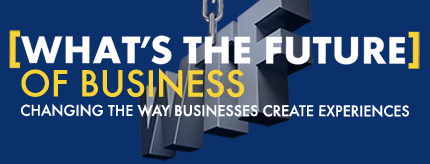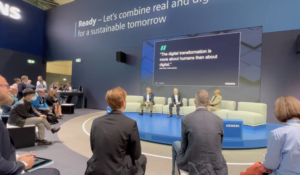
Change is in the air. With disruptive technologies hitting businesses from the outside in and the inside out, how companies invest in technology and ultimately how people use it to get work done is under significant re-evaluation. At the same time, the rising workforce clash between older and younger generations is also pushing HR to radically reform management processes and education programs.
Indeed, change is the air. In fact it’s imminent. But change is never programmatic nor is it ever easy. And, all too often, change is a reactive response to areas of disruption rather than a proactive step to head it off.
With so many factors affecting the future of business, where do leaders focus? What do they prioritize?
This is a worldwide issue. As Gallup research shockingly revealed in late 2013, only 13% of employees around the world are actively engaged at work. What’s worse is that more than twice that number is completely disengaged, toxic and at risk of spreading negativity to others.
It only gets worse.
Deloitte released its Global Human Capital Trends report in in 2014, which included insights from 2,500 businesses in 90 countries. The report’s author Josh Bersin observed a sobering trend, “the message is clear: companies are struggling to engage our modern, 21st century workforce.”
Key findings from Deloitte’s report include:
- 86% of business and HR leaders believe they do not have an adequate leadership pipeline (38% see it as an urgent problem)
- 79% believe they have a significant retention and engagement problem (26% see it as urgent)
- 77% do not feel they have the right HR skills to address the issue (25% urgent)
- 75% are struggling to attract and recruiting the top people they need (24% urgent)
- Only 17% feel they have a compelling and engaging employment brand.
I can sum up my response in one word, “yikes!”
Between Gallup and Deloitte, there’s a screaming sense of urgency that should rattle executives into action. That data is overwhelming. The fear is real. The risk of not doing anything about it or not trying hard or fast enough is self-destructive. What’s clear is that the solutions are not easy. And without leadership commitment, solutions are implausible.
There’s something else to consider. With new technology a constant disruptor and the next generation of employees (Generation Z) already exhibiting different behavior sets than that of Generation Y, we can assume that change isn’t a one-time affair…it’s continual. Therefore change must of course begin with people…by them and for them. To lead though, not just react to threats and trends, requires a more substantial approach. We are talking about changing the culture of the company to be more innovative, adaptive, and resilient. That takes leadership.
Culture starts with vision…a vision for where we are going and why. Leadership must also lead and not rely on processes and systems. People must believe that leadership is relentless in its pursuit for a living and inclusive culture that everyone can stand behind. To design and foster a new culture also takes empowerment against that vision, inclusion so that everyone feels that they are part of its DNA, and most importantly instilling and building trust among leaders, managers, and especially employees.
Complicated yes. Effective, yes. Deloitte found that work teams which have high levels of inclusion outperform others by 8:1.
From there, businesses must overhaul and humanize their performance management process. A new vision sets the bar higher for everyone.
This requires new standards, processes and systems for…
- Management
- Performance
- Training
- Communication
- Collaboration
- Reward and recognition
- Leadership behavior
If it’s one thing you can bet on moving forward is that people, and how you lead and inspire them, will become one of your greatest assets if not an absolute competitive advantage. But what research and experience is already showing is that to succeed here now and in the times ahead takes a reboot of the approach you have today. Just because things have been done a certain way doesn’t mean its going to work in a time when people, what they value, and the technology they use are radically different that the aging infrastructure that manages them today. This is a time for innovation. This is a time to re-write the employee handbook. And, this takes leadership, not management.
ctrl-alt-del
Connect with me…
Twitter | LinkedIn | Facebook | Google+ |Youtube | Instagram | Pinterest
Image Source: Shutterstock





![While AI learns and gets smarter and smarter, I spend my time preparing for the future by… [fill in the blank].
The most important skills of the future are human…
#creativity, #imagination, #individuality, #criticalthinking, #empathy
bit.ly/LifescaleBook 💫
Artist: @asiersanznieto
#promptengineering #prompting #ai #genai #artificialintelligence #keynotespeaker #motivationalspeaker #motivational #motivation #education #learning #leadership #leader](https://briansolis.com/wp-content/plugins/instagram-feed/img/placeholder.png)
Inspirational read Brian!
There are steps and simple tools already available that organizations can use to make the “overhaul” less intimidating. Here are a few examples to help management track performance, encourage professional development/training, increase communication along-side collaboration, build a culture of recognition, and help all employees model desired behaviors.
Of course I’m biased towards @YouEarnedIt 🙂
http://www.entrepreneur.com/article/234798
Thanks for your great work!
Tim Ryan
@YouEarnedIt
Thank you for sharing Tim!
Really interesting read Brian. I do wonder if the solution is solved by the usual suite of human capital solutions, or whether its a simpler issue. If you like your team, your boss and your coworkers.. can you possibly be disengaged? In the age of advanced technology for collaboration, connection and communication, you can escape true relationships at work. Maybe we’re missing the true 1:1 human connection of regular, open, honest verbal communication. Its all too easy to disengage when your connections are names in IMs, emails, webinars and sharepoint discussions rather than actual people you know.
Well said Rachael. Thank you for sharing your thoughts!
Over the years I’ve read multiple HR studies that say every employee shares information about their company with seven people, face to face, outside or the workplace every day. If a company has 100 employees, that is 700 informational moments everyday. Each of those 700 connections will pass on that information to another 7 people within 24 hours (4900 moments). Within three days, that information will be passed to more than 2 million people. If your employees aren’t engaged and knowledgeable about your company, think about the damage they are doing to your corporate image in just a week. Now multiply all of that by 120 (average number of online social connections for everyone) and refill your antidepressant prescription.
Thanks for the sobering comment Lou!
I think it was the author of “Good To Great” who popularized the theme of “Getting The Right People On The Bus” relative to hiring so that you’re not trying to re-program people who are the wrong fit for your culture.
Of course, it has always been important to attract star players but it is easier said than done. Especially in this age we’re in.
I’m a big proponent of the premise of, “Do the opposite of what the ineffective majority are doing.”
Everyone who hires asks for resume and application.
And the fact is, most people that are hired, are mis-hires.
So naturally, following this norm isn’t going to get you the best possible results.
Pretty much everyone gets horrible to average results with hiring this way so if you want to get those results, go ahead and do what everyone else is doing.
If you want to really master the process of hiring the right people, I believe in getting rock solid and winning hiring strategies from Brad Smart’s book, “Top Grading”. Some of the sharpest business minds on the planet consider this to be the best book ever written on the topic of hiring.
Hiring the wrong people is very expensive not only in terms of money, but also in time and in opportunity costs. And I love it Brian how you’re asking people to innovate when it comes to their employees. It is definitely a place worthy of optimization in every business.
Great comment Lewis and yes, “Good to Great” was…great!
Really appreciate you sharing your thoughts here with us. Thanks for being part of the community.
Change must begin with people.. “by them and FOR them.” Emphasis mine as that’s the point a lot of what I’ll dub ‘old guard’ minded companies miss in their pursuit of stock valuations and share and sales; they miss the People. The sell to customers, instead of building and creating for them; easy counter ex. is Apple. They treat employees as expense not investment, think of what benefits costs the company w/out considering what it does for the employees and the business; think lifestyle, happiness, productivity.. how many startups born of the minds of unfulfilled, unsatisfied, untapped employees.
Not all of course but far too many companies still have too many layers managing, not leading the underpaid, under-valued front line – where the real work is done. By people. As you say it’s the companies that see people – and not their resumes – as their great advantage that will attract the top talent, smart teams that produce the best results. FWIW.
Love it Davina. Thank you for adding to the conversation….
Great post, Brian, and timely. The workforce of today is more demanding – and more difficult to satisfy – than yesterday’s workforce. Expectations are going up because with technology things are getting simpler, faster, and more relevant in everyday life, but… in the workplace? Not so much, usually.
Kinect for Xbox can track the movement of your pupils and read your heart rate by looking at your skin, but most employers don’t even know how to relate to their own employees in an authentic way!
One thing I would add to your comment about building a culture, and that is that it has to bubble up from the bottom. Leadership is important, the way a sailboat captain’s handling of the sails can steer a boat, but the wind’s direction and strength come from the desires, beliefs, and ambitions of individual employees, connected socially with each other.
Don, such a big fan of your thinking and work. Proud to have you as a friend. Love the comment. Well said!
Brian, Nice work. I feel that it is vitally important for senior management through middle level management to communicate the vision of the organization to the workforce and relate each team member why they are necessary in the big scheme of vision realization for the entire organization. If the know how vital it is for them to show up, contribute/deliver you end up with folks that innovate of their own accord and not folks that just punch a clock.
And to Don’s point about bubbling up, if the individuals understand why they come to work they become part of the team that contributes to the organization.
Steve
Cheers Steve!